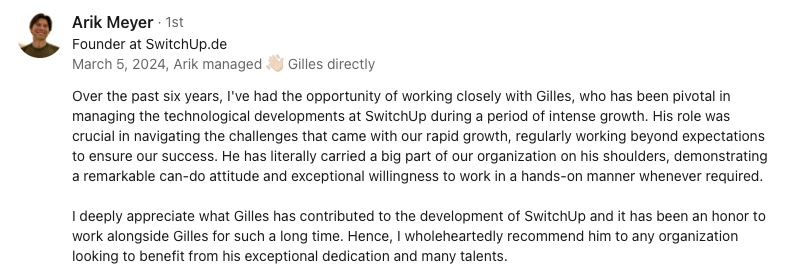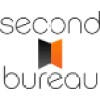Leaving tech smoothly how to plan exits that work for everyone
Abstract:
The article provides a comprehensive guide to managing a smooth and considerate exit from a tech role, emphasizing that a well-planned departure is about much more than finishing your own tasks—it involves thoughtful coordination with a wide array of stakeholders, from direct teammates and cross-functional partners to external clients, IT, and even family. It highlights practical strategies, including mapping out all affected relationships using visual tools, creating shared transition timelines that account for both project deadlines and local customs (such as varying European notice periods and holiday blackout dates), and communicating proactively to prevent confusion and maintain trust. The article also underscores the value of meaningful rituals for knowledge transfer and team morale, the importance of phased handovers, and the need for ongoing feedback and agile adjustments to address surprises. Drawing from personal experience managing multicultural teams in China, Germany, and Portugal, the author illustrates how setting clear boundaries and advocating for personal needs ensures that exits remain healthy and sustainable for both individuals and organizations. Through a friendly and sometimes humorous tone, the article encourages treating departures as opportunities for growth and shared success, rather than stressful disruptions, and stresses the long-term benefits of thoughtful planning, open communication, and mutual support.
When I left my CTO role in Berlin, I realized it was rarely just about clearing my desk and waving goodbye. Each time, it set off a chain reaction that reached far beyond my immediate team—sometimes in ways I never expected. Miss one important stakeholder, and suddenly the IT desk is in chaos or a client is left in the dark. A smooth exit, I learned, isn’t just about wrapping up my own work, but about making sure every connection and expectation is clear and handled.
This article is my attempt to share what I’ve learned from managing multicultural teams in China, Germany, and Portugal. I’ll walk through how I handle different stakeholders, timelines, and local customs during a departure. You’ll find practical strategies for spotting who’s really impacted, tools for mapping relationships, and ways to build a shared transition timeline. I’ll also share some stories—good and bad—about regional differences, from notice periods to holiday blackouts, and offer tips for clear, proactive communication.
I’ll talk about how farewell rituals can help with knowledge transfer and team morale, and give advice for planning your exit to avoid tricky or stressful times. I’ll also cover how I use feedback to stay flexible, and why protecting my own boundaries is just as important as supporting the team.
I try to keep the tone friendly, sometimes a bit humorous—because, honestly, careful planning can turn a stressful process into a positive step for everyone. Or at least, that’s what I keep telling myself.
Mapping stakeholders for a smooth exit
Who is really impacted?
When I decided to leave a tech role, I often thought only my closest colleagues would care. But, more than once, I discovered too late that a forgotten client or another department was left scrambling. It’s easy to miss these wider connections, leading to last-minute surprises or missed steps. By noticing everyone touched by a departure, I’ve managed to avoid these hazards and set up a smoother exit. Here’s how I break down the main groups usually affected:
- Direct team: Colleagues I work with every day.
- Cross-functional collaborators: People in product, marketing, or operations working on shared projects.
- External clients or partners: Folks outside the company who expect things to keep running.
- IT and data security: Teams who manage system access and safety.
- Knowledge management: People who capture and share important know-how.
- Family: My support at home, who also feel shifts in work-life balance.
Leaving any of these groups out can cause hiccups or missed handovers. Making a full list helps ensure things go smoothly. Understanding the groups is one thing; seeing how they connect is even better.
It’s a bit like passing a relay baton—every stakeholder is a runner waiting for their turn. If someone is missing, the whole group can stumble. Or, as I sometimes joke, it’s like an orchestra: miss just one player, and the tune is off. Each person plays a part in your exit. Missing even one can throw things off track.
I’ve seen these misses happen more often than you’d think. For example, 41% of tech exits skip cross-functional groups, 67% neglect people outside the company, and 48% forget IT or data security. These oversights can lead to delays, gaps in knowledge, or even problems with data safety. Missing important people isn’t just a small mistake—it can slow projects or cause compliance troubles. So mapping these relationships is the next step.
Tools for mapping relationships and dependencies
Visual maps help me make sense of all the different people and processes involved. I like using a power-interest grid or stakeholder models to sort out who needs to be told, consulted, or prepared for my leave. Laying it out visually makes it easier to spot missing connections and focus on what’s most important. The simple power-interest matrix is a favorite of mine.
With this grid, I put names based on their influence and how much my departure affects them. Those with both high influence and a strong interest—like managers or key clients—deserve the most attention. Others might just need to be kept in the loop. Once, I realized too late that marketing depended on my weekly updates, and IT needed to shut down my accounts. That was a headache I don’t want to repeat.
But it’s not just about people. I also check other dependencies. Who needs my knowledge, account access, or sign-off? A checklist might show only I have an admin password or know how to pull a certain report. By mapping these, I can catch surprises before they appear. With my map ready, it’s time to coordinate everyone’s needs for the exit.
Building a shared transition timeline
Coordinating milestones for a seamless exit
Leaving isn’t just picking my last day. More than once, I planned my exit and then realized my notice overlapped with a busy product launch or audit. That meant tension and missed deadlines. A shared transition calendar—matching personal exit steps with project milestones, team tasks, and company events—helps dodge these headaches. Putting everyone’s expectations in one place makes it easier to get through the process together. To start, I gather the big dates from all involved.
Setting up contingency triggers and fallback pointsOne thing I learned the hard way, especially when moving into freelance work, is to set up clear contingency triggers. For example, if my freelance revenue doesn’t reach €3,000/month by week 4, I delay my full exit by two weeks. Or, if a key client acquisition target isn’t met, I keep my current role part-time until things stabilize. Here are some fallback triggers I’ve used:
- If freelance revenue does not reach €X/month by week 4, delay full exit by two weeks.
- If a replacement is not hired by week 6, extend notice period by one week.
- If client onboarding is delayed, maintain access to key systems for an extra month.
- If critical project milestones slip, adjust handover dates accordingly.
Having these triggers in place gives me peace of mind and keeps the transition from turning into a financial or operational disaster.
Gathering key dates and aligning priorities
I start by collecting important dates from those affected by my transition. This could mean a quick chat with team leads, project managers, or HR to track upcoming launches, meetings, audits, or reviews. My checklist usually looks like this:
- List current projects and big milestones
- Note routine events like regular reports
- Mark any outside deadlines or filings
Bringing these into the mix helps me avoid clashing with major work and keeps things moving. Once I have the dates, I make them visible for everyone.
Practical tools for visualizing overlaps
Digital project tools help sort out deadlines and jobs, showing where my tasks overlap with the team’s needs. I’ve used Gantt charts, Trello, Asana, shared Google calendars, and even Monday.com or Smartsheet for workflow management and audit trails. Sometimes, I just sketch it out on paper—whatever works.
Once, in Portugal, I realized too late that my planned handover clashed with Carnival week. It was a bit like herding cats—everyone was out, and nothing got done. Now, I always double-check for local holidays.
The value of open timelines
When everyone can see the same timeline, problems are caught sooner, which cuts stress. If a key task lands during someone’s vacation, an open calendar helps me reschedule it easily. Shared timelines build trust and prevent last-minute panic, giving confidence that things won’t slip. But every workplace has unique factors—regional realities can still trip up even the best plans.
Regional and organizational realities
Notice periods and handover customs
Planning a transition in Europe comes with its own set of rules. Notice periods and handover customs differ by country and job. For example, in Germany, I had to give a four-week notice—sometimes up to three months in tech. In France, managers often need to give three months. In the UK, it’s usually one week per year of service, but in tech, it’s often one to three months. The Netherlands and Sweden may ask for one to three months, sometimes even six for senior jobs.
When I moved from Berlin to Lisbon, I was caught off guard by how relaxed the handover process was in Portugal compared to the strict, almost military precision in Germany. In Berlin, I had a checklist for everything and a calendar full of meetings. In Lisbon, people just shrugged and said, “We’ll figure it out.” It was a cultural shock, and I had to adjust my expectations—and my planning.
Factoring in holidays and low-staffing periods
Overlooking holidays, school breaks, or slow times can mess up even a great transition plan. With teams spread across countries, I’ve accidentally scheduled a key handover during a big holiday somewhere else, leaving people unavailable. For instance, transitions planned for August in France or December in Germany risk working with thin teams, making it hard to do proper handovers. Buffer times and blackout dates help here.
Using buffer periods and blackout dates
Many global teams add buffer periods around big holidays or use blackout dates, like end-of-year breaks, where no major handovers should happen. This keeps things smooth and morale up. For example, leaving a two-week gap before and after the winter holidays can prevent rushed or incomplete transfers. Respecting these times helps both work quality and team spirit. Aligning handover timelines across multiple countries is never easy—sometimes it feels like trying to solve a Rubik’s cube blindfolded.
Communication rhythms and rituals
Designing a proactive communication plan
People often start guessing and gossiping about departures before anything is official. I remember once in Beijing, I was still negotiating my exit, but rumors had already spread that I was leaving for a competitor. Sharing info early and openly helps build trust and stops rumors. Every group, though, needs a message that fits their role.
I tailor my communications:
- Immediate team: Give them an early heads-up and keep them informed.
- Leadership: Focus on project impacts and plans for next steps.
- Clients/partners: Reassure them things will keep running, introduce new contacts.
- Cross-functional teams: Share details on how processes will change.
Choosing the right way to share matters too:
- In-person meetings: For sensitive or complicated updates
- Email: For official or wider messages
- Digital chat (Slack, Teams): For regular, informal check-ins
- Shared docs/dashboards: For handover progress and FAQs
I don’t stop at initial messages. Ongoing updates, even just saying there’s “no news,” help everyone keep up and avoid stress. Letting people ask questions—by email, forms, or open hours—also helps teams feel included.
Rituals for closure and knowledge transfer
Small farewell rituals, like a team lunch or a thank-you speech, can help people cope with loss and build morale. In China, my team once organized a “knowledge dumpling party”—we made dumplings together while I shared stories about past projects and tricky bugs. It was both fun and practical, and I still remember the warmth of that evening. These moments let teams show appreciation and say goodbye in a way that feels complete.
Passing on knowledge is just as important. Organized sessions—like walkthrough meetings, checklists, or recorded guides—make sure my know-how isn’t lost.
- Hold handover meetings with key folks
- List critical tasks or contacts
- Record video walkthroughs for tricky parts
Mixing social and task-based rituals works well. Some companies hold “knowledge farewell” events that mix sharing stories with real handover work, making it both useful and meaningful. The most memorable for me was in Berlin, where my team surprised me with a “bug-fix relay”—each person took over one of my recurring headaches, and we laughed about it over beers. It made the transition feel lighter, even if I was a bit sad to go.
Anticipating disruption and planning smoother exits
Spotting operational and emotional peaks
Leaving during busy times can set off a wave of delays and stress. Walking out just before a product launch or at the end of a financial quarter can stall projects and push back deadlines. High-profile companies have stumbled this way before, losing momentum or even money because the right people weren’t around at the right moment.
There’s also the emotional side. If my exit comes on the heels of layoffs, a management shakeup, or personal team changes, people’s stress and uncertainty can climb. Research shows that stacking several tough changes together drops morale and makes focus harder. A sudden exit at these times can be the tipping point, leaving others feeling just plain worn out.
And then there’s the financial reality. When I first transitioned to freelance, I underestimated how long it would take to build a stable income. I had to juggle part-time consulting while still wrapping up my old job. It wasn’t glamorous—just a lot of spreadsheets and late-night worries. If you’re moving to independent work, keep a close eye on your numbers and set clear revenue milestones before you fully let go.
A few basic tips help avoid these tough peaks:
- Add buffer time before and after key launches, audits, or holidays
- Use shared calendars to spot conflicts early
- Talk with team leads, HR, and others before setting dates
- Try not to leave or hand over duties during very stressful periods
A little planning and early chats go a long way toward avoiding chaos. But even with care, some bumps are bound to happen—most can be eased with preparation and teamwork.
Minimizing disruption through phased transitions
Phased exits help things go more smoothly. Here, the outgoing and incoming teammates overlap, or duties shift in stages. When I transitioned out of my CTO role in Berlin, I used a phased handover, attending meetings with my replacement for two weeks. This overlap made the process less stressful for everyone. The new person could ask questions, and I could fill in the gaps before disappearing for good.
A typical phased handover involves:
- Shadow sessions for the newcomer to watch the daily work
- Meetings with key people to pass on relationships and knowledge
- A gradual shift, not a one-day swap
Good documentation ties it all together. Outgoing staff can make guides, record videos, or list contacts and tasks. Tools like Process Street or Google Workspace help standardize this info and keep it easy to find. A solid paper trail makes things easier for those stepping in later on—and less is forgotten.
Still, no plan is perfect. Building in feedback and staying flexible helps smooth surprises.
Staying flexible with feedback and adjustment
Building feedback loops into your exit
Structured feedback helps spot small problems before they grow. I gather feedback through surveys, exit interviews, one-on-one talks, or digital channels. Everyone shares best in their way—some are open in person, others on paper. Bringing all options into my exit means hidden snags get caught early and fixed.
In Beijing, I found that regular feedback sessions—sometimes just a quick chat over lunch—helped catch issues before they became real problems. Instead of just one exit interview at the very end, I set up checkpoints along the way: a quick survey after the first handover, a midpoint chat, and an option for anonymous feedback. This makes it easier to address issues promptly and keeps the transition improving as it goes.
Research shows that collecting feedback throughout helps everyone involved feel better equipped, and leads to smoother handovers and even better retention. Some studies say companies who act on real-time feedback see fewer people quitting again soon after. Using feedback as part of the plan leads to better results for all. But feedback only matters if I act—here’s how I adapt.
Adapting the plan with agility
I treat my exit like an evolving process, not a fixed checklist. Agile thinking—meaning regular updates and quick changes to the plan—lets me respond fast. If someone raises a new problem, I adjust right away rather than waiting for a bigger mess. Staying flexible helps everyone keep moving together.
I might:
- Set short feedback windows, like every week or two
- Check progress with stakeholders each time
- Update tasks and plans when things change
- Write down new changes and share them with all
These steps keep transition plans current and practical, whatever comes up. They make the process less risky and easier to manage.
Teams using agile updates are usually happier and face fewer headaches. When plans can shift as needed, everyone feels more included and ready for what’s next. This approach also encourages people to support each other—not just stick to rigid steps. Still, none of it works unless I protect my own boundaries.
Protecting boundaries and serving the organization
Setting limits to keep exits healthy
Without clear limits, an exit can stretch on and on—suddenly, I’m pulled into endless talks, hit with surprise questions, or asked to help long after goodbye. This happens often, especially if others relied on me a lot. For me, in Berlin, it was always the same story: “Just one more thing, can you help with this bug?” I learned to set hard finish dates for handover tasks. Make a checklist for handovers, docs, and meetings. This shows everyone what’s expected—and not expected—so my time is protected. Visual aids and checklists are handy for making limits clear, so all agree when things are done.
Joining in rituals or sharing knowledge should also fit my needs. Making these things optional, rather than required, helps keep the process supportive, not stressful. Let people decide how involved to be. This way, the handover is useful and kind.
Looking after my needs isn’t selfish—it’s necessary for doing a good job for myself and the team. After leaving a large team, I sometimes felt isolated and a bit lost. It’s easy to get caught up in being helpful, but if I don’t set boundaries, I end up drained and resentful. I’ve learned (the hard way) that my mental health and work-life balance matter just as much as a smooth handover.
Advocating for my own needs
Healthy exits take teamwork. I speak up about what I can and can’t do—whether that means saying no to last-minute jobs or asking for flexibility with rituals. It also helps to tap into support, like counseling or talking with peers, especially if the change is weighing on me. These acts not only help me, but show others that it’s okay to set limits.
A good transition shouldn’t load all the pressure onto the person leaving. True success comes from shared effort and understanding, not someone burning out to hold it all together. When everyone sets clear limits and splits the work, exits become smoother. Having managed multicultural teams in China, Germany, and Portugal, I know firsthand that clear boundaries and shared responsibility go a long way in making sure transitions don’t result in burnout—for anyone. This shared approach is better for everyone in the long run.
My tactical exit roadmap: step-by-step checklist
Here’s the simple roadmap I use for my own exits. It’s not fancy, but it works:
-
Notice
- Inform manager and HR
- Set initial last working day
- Communicate to immediate team
- Inform manager and HR
-
Stakeholder mapping
- List all impacted groups (team, clients, IT, etc.)
- Map dependencies (access, knowledge, approvals)
- List all impacted groups (team, clients, IT, etc.)
-
Timeline planning
- Gather key dates (launches, audits, holidays)
- Build shared calendar
- Identify blackout periods and buffer times
- Gather key dates (launches, audits, holidays)
-
Contingency triggers
- Set revenue or client acquisition targets
- Define fallback points (delay exit, extend access, etc.)
- Set revenue or client acquisition targets
-
Communication plan
- Tailor messages for each group
- Schedule updates and Q&A sessions
- Tailor messages for each group
-
Knowledge transfer
- Organize handover meetings
- Create documentation and walkthroughs
- Hold farewell rituals (team lunch, knowledge party, etc.)
- Organize handover meetings
-
Phased handover
- Overlap with replacement if possible
- Gradually shift responsibilities
- Monitor progress and adjust as needed
- Overlap with replacement if possible
-
Feedback and adjustment
- Collect feedback at each stage
- Update plan based on input
- Share lessons learned
- Collect feedback at each stage
-
Boundary setting
- Define end date for support
- Make participation in rituals optional
- Prioritize mental health and work-life balance
- Define end date for support
-
Pilot launch (if freelancing/consulting)
- Test new revenue streams
- Adjust exit timing if targets not met
- Test new revenue streams
Leaving a tech job is never just ticking boxes. For me, it’s about thoughtfulness, respect for local ways of working, and paying attention to the emotional side. By mapping out stakeholders, planning together, and talking openly, I’ve managed to avoid most messy surprises and slipping deadlines. Visual tools and feedback catch problems early, while rituals and handovers keep knowledge and morale strong. And honestly, setting my own limits is just as important as serving the team. If I’ve learned anything, it’s that a well-handled exit opens new doors for everyone—sometimes in ways you can’t predict. If you’re planning your own transition, take a moment to think about what worked (or didn’t) in your past moves. You might be surprised by what you discover.














